

Ediacaran. The Ediacaran Period's status as an official geological period was ratified in 2004 by the International Union of Geological Sciences (IUGS), making it the first new geological period declared in 120 years.[3][4][5] Although the Period takes its name from the Ediacara Hills where geologist Reg Sprigg first discovered fossils of the eponymous biota in 1946, the type section is located in the bed of the Enorama Creek[6] within Brachina Gorge[7] in the Flinders Ranges of South Australia, at WikiMiniAtlas Ediacaran and Vendian[edit]
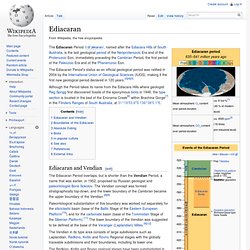
Ediacara biota. Multicellular organism. Few unicellular species can be seen individually with the naked eye.
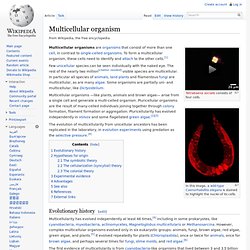
The rest of the nearly two million[citation needed] visible species are multicellular. In particular all species of animals, land plants and filamentous fungi are multicellular, as are many algae. Some organisms are partially uni- and multicellular, like Dictyostelium. Fossil. Fossilization processes Silicified (replaced with silica) fossils from the Road Canyon Formation (Middle Permian of Texas).
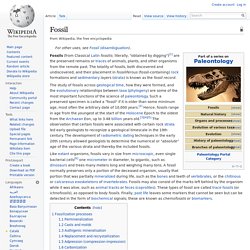
The star-shaped holes (Catellocaula vallata) in this Upper Ordovician bryozoan represent a soft-bodied organism preserved by bioimmuration in the bryozoan skeleton.[7] The process of fossilization varies according to tissue type and external conditions. Permineralization Permineralization is a process of fossilization that occurs when an organism is buried. Casts and molds. Onega stepanovi. Onega stepanovi is a fossil organism from Ediacaran deposites of the Arkhangelsk Region, Russia.
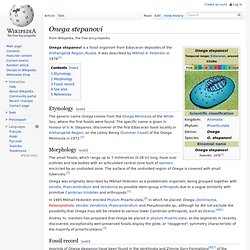
It was described by Mikhail A. Marywadea. Ediacaria. Ediacaria is a fossil genus dating to the Ediacaran Period of the Neoproterozoic Era.
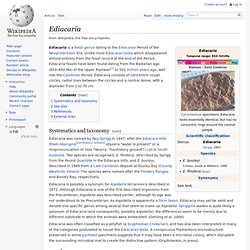
Unlike most Ediacaran biota which disappeared almost entirely from the fossil record at the end of the Period, Ediacaria fossils have been found dating from the Baikalian age (850–650 Ma) of the Upper Riphean[1] to 501 million years ago, well into the Cambrian Period. Ediacaria consists of concentric rough circles, radial lines between the circles and a central dome, with a diameter from 1 to 70 cm. Systematics and taxonomy[edit] Ediacaria was named by Reg Sprigg in 1947, after the Ediacara Hills (from Aborigine[verification needed] Idiyakra "water is present" or a mispronunciation of Yata Takarra, "hard/stony ground"[1]) in South Australia. Two species are recognised: E. flindersi, described by Sprigg from the Pound Quartzite in the Ediacara Hills, and E. booleyi, described in 1995 from a Late Cambrian deposit at Booley Bay (County Wexford), Ireland. Charnia. Charnia is the genus name given to a frond-like Ediacaran lifeform with segmented ridges branching alternately to the right and left from a zig-zag medial suture.
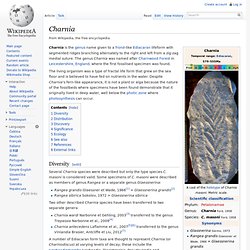
The genus Charnia was named after Charnwood Forest in Leicestershire, England, where the first fossilised specimen was found. The living organism was a type of fractal life form that grew on the sea floor and is believed to have fed on nutrients in the water. Despite Charnia's fern-like appearance, it is not a plant or alga because the nature of the fossilbeds where specimens have been found demonstrate that it originally lived in deep water, well below the photic zone where photosynthesis can occur. Diversity[edit] Several Charnia species were described but only the type species C. masoni is considered valid. Rangea grandis Glaessner et Wade, 1966[1] = Glaessnerina grandis[2]Rangea sibirica Sokolov, 1972 = Glaessnerina sibirica Two other described Charnia species have been transferred to two separate genera.
Dickinsonia. Etymology[edit] Dickinsonia was first described by Reg Sprigg, the original discoverer of the Ediacaran biota in Australia,[4] who named it after Ben Dickinson, then Director of Mines for South Australia, and head of the government department that employed Sprigg.
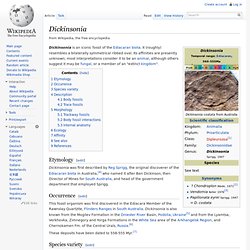
Occurrence[edit] This fossil organism was first discovered in the Ediacara Member of the Rawnslay Quartzite, Flinders Ranges in South Australia. Dickinsonia is also known from the Mogilev Formation in the Dniester River Basin, Podolia, Ukraine[5] and from the Lyamtsa, Verkhovka, Zimnegory and Yorga Formations in the White Sea area of the Arkhangelsk Region, and Chernokamen Fm. of the Central Urals, Russia.[6] These deposits have been dated to 558-555 Myr.[7] Species variety[edit] Schematic reconstructions of Dickinsonia costata, D. lissa, D. tenuis, D. menneri, D. sp. and Ivovicia rugulosa. Arkarua. Arkarua adami is a small, Precambrian disk-like fossil with a raised center, a number of radial ridges on the rim, and a five-pointed central depression marked with radial lines of 5 small dots from the middle of the disk center.
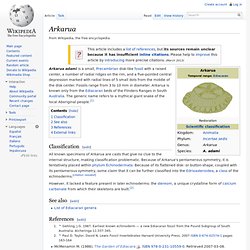
Fossils range from 3 to 10 mm in diameter. Arkarua is known only from the Ediacaran beds of the Flinders Ranges in South Australia. The generic name refers to a mythical giant snake of the local Aboriginal people.[1] Treptichnus pedum. Treptichnus pedum has a fairly complicated and distinctive burrow pattern: along a central, sometimes sinuous or looping burrow it made successive probes upward through the sediment in search of nutrients, generating a trace pattern reminiscent of a fan or twisted rope.[4] The organism that left such traces is considered more complex than earlier Ediacaran fauna; and these trace fossils, which occur worldwide, are usually found in strata above those.[5] Since only its burrows have been found, it is presumed that the Treptichnus animal lacked any hard anatomical features, such as shells or bones.

Its morphology and relationship to modern animals is therefore unknown, and some dispute even its inclusion within the animal kingdom.[6] Despite this lack of fossil evidence, surface trails produced by modern priapulid worms exhibit the same probing morphology as Treptichnus, suggesting a close anatomical relationship between the trace-maker and modern priapulids.[7] Pteridinium. Pteridinium is an erniettomorph found in a number of Precambrian deposits worldwide.
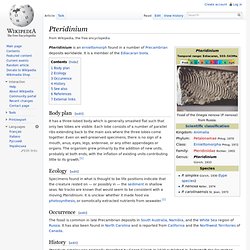
It is a member of the Ediacaran biota. Body plan[edit] It has a three-lobed body which is generally smashed flat such that only two lobes are visible. Marinoan glaciation. Neoproterozoic Snowball Periods A recent estimate of the timing and duration of Proterozoic glacial periods. Note that great uncertainty surrounds the dating of pre-Gaskiers glaciations. The status of the Kaigas is not clear; its dating is very tentative and many researchers do not recognise it as a glaciation.[1] An earlier and longer possible snowball phase, the Huronian glaciation, is not shown here. The Marinoan glaciation was a period of worldwide glaciation that lasted from approximately 650 to 635 Ma (million years ago) during the Cryogenian period.
Yorgia. Yorgia waggoneri is a discoidal Ediacaran, resembling a cross between the organisms Dickinsonia and Spriggina. It has a low, segmented body consisting of a short wide "head", no appendages, and a long body region, reaching a maximum length of 25 cm (9.8 in).